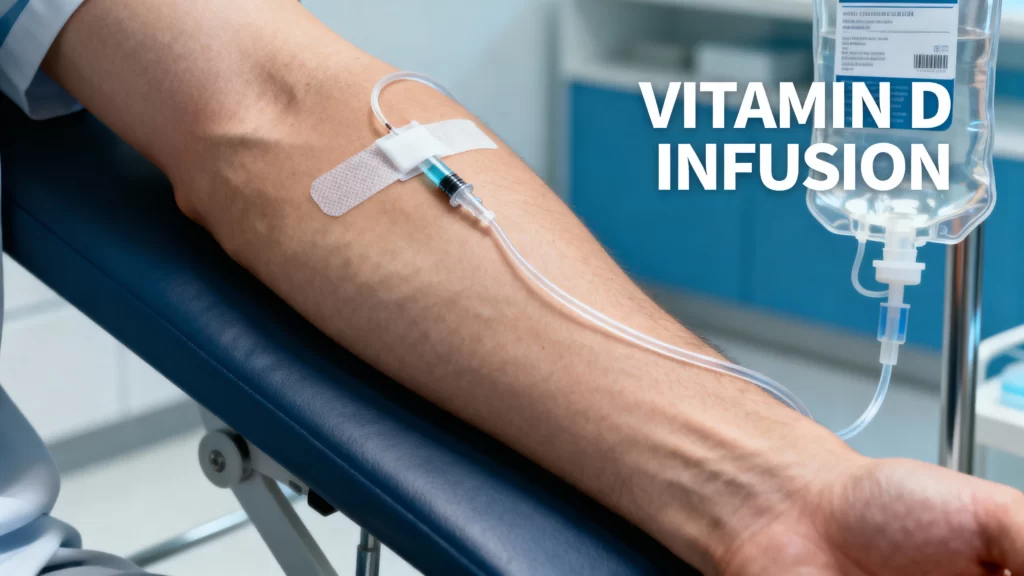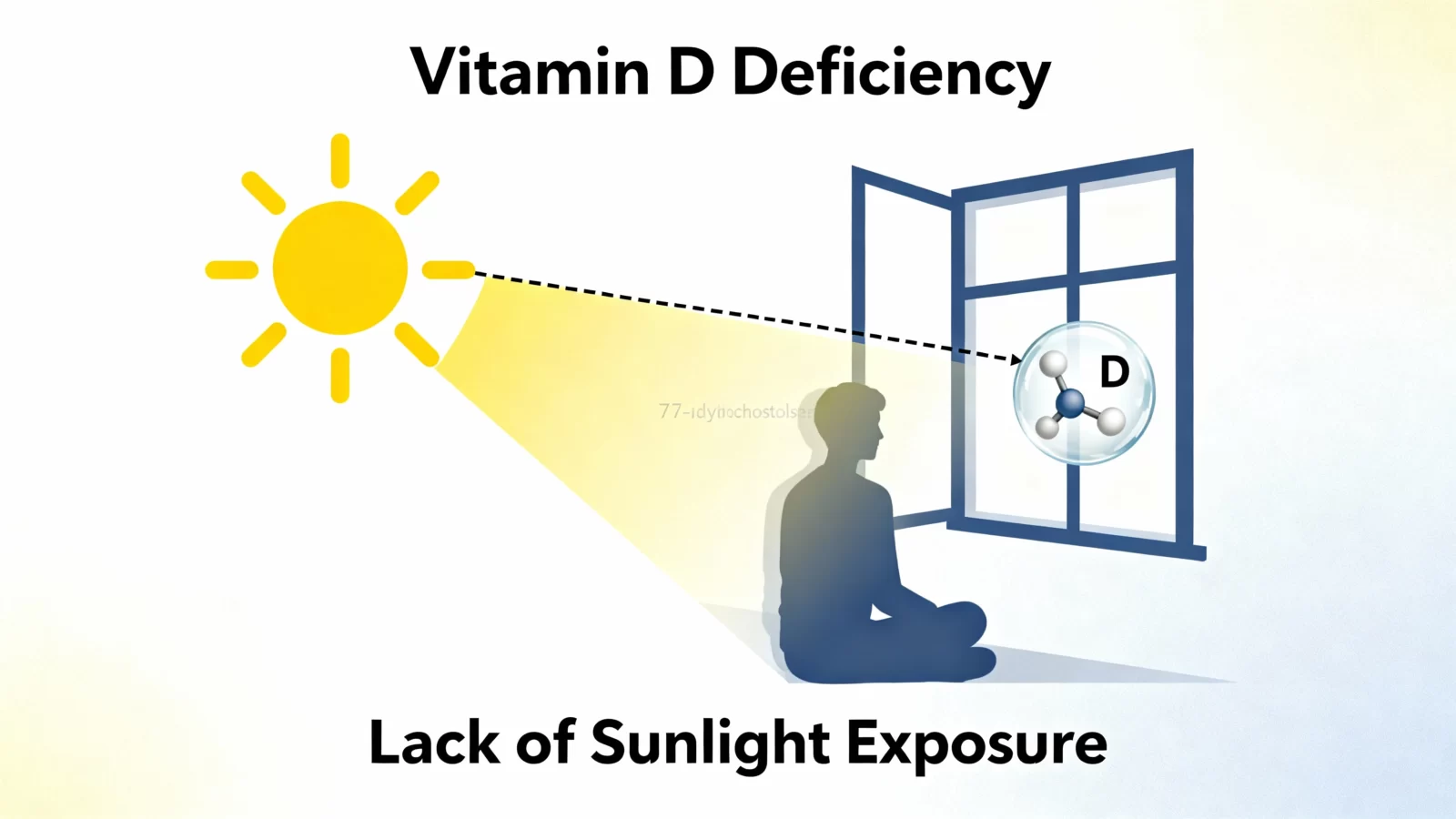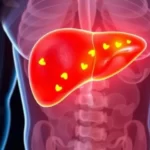Vitamin D is often called the “sunshine vitamin”, yet deficiencies are far more common than many expect. Limited sunlight exposure, indoor lifestyles, and certain health conditions contribute to low levels, which can affect bones, immunity, and energy. Correcting a deficiency usually starts with dietary supplements or injections, but for some individuals, these methods don’t deliver results quickly enough.
This is where vitamin D infusion therapy comes in. By delivering vitamin D directly into the bloodstream through an IV drip, the body absorbs the nutrient more efficiently compared with tablets or capsules. For those dealing with persistent fatigue, fragile bones, or repeated illness due to deficiency, infusion therapy offers a faster route to restoring balance.
In this guide, every aspect of vitamin D infusion therapy will be explored, from its benefits and risks to the research behind it. By the end, the goal is to provide clear, evidence-backed information to help readers make informed decisions about whether this treatment could be right for their situation.
2. What is Vitamin D Infusion Therapy?

Vitamin D infusion therapy involves administering the vitamin directly into a vein through an IV drip. Instead of passing through the digestive system, the nutrient enters the bloodstream immediately, ensuring rapid and complete absorption. This approach is especially useful for individuals whose bodies struggle to process oral supplements due to gut or liver conditions.
There is more than one way to restore low vitamin D levels, and the choice often depends on how severe the deficiency is, how fast correction is needed, and whether the body can absorb nutrients properly through digestion. Infusion therapy is not the only method available, but it does stand out when compared with other approaches.
- Oral supplements: The most common option is taking vitamin D tablets, capsules, or drops. They are easy to find at pharmacies and convenient for daily use. However, their effectiveness depends on consistent intake and the body’s ability to absorb the vitamin through the digestive system, which can sometimes be unreliable.
- Vitamin D injections: A single intramuscular shot that delivers a concentrated dose of vitamin D. This method can provide long-lasting effects, often for weeks or months, but it may not suit individuals who dislike needles or need more gradual dosing.
- Infusion therapy: Delivered slowly through an IV drip, infusion offers steady absorption directly into the bloodstream. This makes it a preferred choice for patients who need quick results or have conditions that limit absorption from pills or injections.
A typical vitamin D infusion therapy session lasts between 20 and 60 minutes. The process is generally painless, aside from the brief discomfort of inserting the IV line. During the drip, patients often sit comfortably, read, or use their phone until the session is complete.
How often someone needs an infusion depends on their age, gender, and overall health condition. The table below outlines common recommendations:
| Group | Typical Need | Frequency of Infusion (General Estimate) |
| Adult men (19–50 yrs) | Maintain healthy bone & muscle function | Every 3–6 months if deficiency is moderate |
| Adult women (19–50 yrs) | Support bone density, especially in pre-menopause | Every 3–6 months, depending on deficiency levels |
| Older adults (51+ yrs) | Higher risk of bone loss & fractures | Every 2–4 months if deficiency is significant |
| Pregnant or breastfeeding women | Increased demand for maternal & infant health | As prescribed, often every 2–3 months |
| Children & adolescents | Growth and bone development | Usually managed with supplements; infusions only if deficiency is severe |
3. Why is Vitamin D Important for Health?
Vitamin D plays a role in far more than just bones. It is a fat-soluble vitamin that influences multiple systems in the body, acting almost like a hormone. Low levels can quietly affect energy, mood, and even long-term disease risk, which is why correcting deficiency is so important.
3.1 Bone Strength and Calcium Absorption
Strong bones depend on calcium, but calcium cannot be absorbed efficiently without vitamin D. A deficiency can weaken the skeletal system, leading to conditions such as osteoporosis in adults and rickets in children. Maintaining adequate vitamin D levels through vitamin D infusion therapy or supplements ensures bones remain dense and resilient against fractures.
3.2 Immune System Support
The immune system relies on vitamin D to activate certain defense cells that fight infections. Studies have shown that maintaining adequate levels through vitamin D infusion therapy may reduce the frequency of colds, flu, and other respiratory infections. Individuals who often fall sick may find their immune response improves when deficiency is corrected.
3.3 Mood Regulation and Mental Health
Vitamin D interacts with neurotransmitters that regulate mood. Low levels have been linked to higher rates of depression and Seasonal Affective Disorder (SAD). By supporting serotonin production, adequate vitamin D can contribute to a more stable emotional balance and improved mental well-being.
3.4 Muscle Strength and Energy Levels
Muscles require vitamin D to contract effectively. Without it, weakness, fatigue, and slower recovery from exercise or injury become more common. Athletes and older adults especially benefit from maintaining healthy vitamin D status, as it supports both physical performance and day-to-day energy.
4. Who Might Need Vitamin D Infusion Therapy?

Not everyone with low vitamin D levels requires an infusion. For many, oral supplements are enough to restore healthy levels. Vitamin D infusion therapy usually becomes an option when deficiency is severe, persistent, or when absorption problems prevent the body from using nutrients effectively.
Common Causes of Vitamin D Deficiency
Vitamin D deficiency is widespread, and the reasons behind it often extend beyond diet alone. Lifestyle habits, medical conditions, and even medications can interfere with how much vitamin D the body produces or absorbs. Some of the most common causes include:
- Limited exposure to sunlight due to indoor living, cloudy climates, or sunscreen use
- Diets low in vitamin D-rich foods such as oily fish, fortified milk, or eggs
- Medical conditions that impair absorption, including celiac disease, Crohn’s disease, and certain liver disorders
- Medications such as anticonvulsants or glucocorticoids, which may interfere with vitamin D metabolism
Symptoms of Deficiency
Low vitamin D levels often develop gradually, which makes it easy to overlook the early signs. The body, however, provides subtle clues when levels are dropping too far. Recognizing these symptoms can help in identifying deficiency before it leads to long-term health problems:
- Persistent fatigue or low energy
- Muscle weakness or cramps
- Bone or joint pain
- Frequent infections or slower recovery from illness
- Low mood or symptoms of depression
Blood tests remain the most reliable way to confirm deficiency, but these signs should not be ignored.
At-Risk Groups
While anyone can experience low vitamin D levels, some individuals face a greater risk due to age, lifestyle, or health conditions. For these groups, infusion therapy may be considered when supplements or injections are not enough.
- Older adults: As the body ages, the skin loses much of its ability to produce vitamin D from sunlight. This reduced efficiency, combined with less time spent outdoors, makes deficiency more likely in older age.
- Individuals with darker skin tones: Melanin provides natural protection against UV rays, but it also reduces the skin’s capacity to generate vitamin D. This means those with darker skin often need more sun exposure to maintain the same levels as others.
- Pregnant and breastfeeding women: Nutritional needs increase significantly during pregnancy and breastfeeding, as vitamin D supports both maternal bone health and the baby’s development. Without supplementation or therapy, deficiencies may appear more quickly.
- People with limited sun exposure: Those who live in northern climates, work night shifts, or wear clothing that covers most of the body often struggle to get enough sunlight for natural vitamin D production.
- Patients with malabsorption disorders: Conditions like Crohn’s disease, celiac disease, or chronic liver issues can make it difficult for the body to absorb vitamin D from food or tablets. In such cases, vitamin D infusion therapy provides a more dependable way to restore levels quickly.
5. Benefits of Vitamin D Infusion Therapy
Correcting a deficiency can make a noticeable difference in health and quality of life. While supplements help over time, vitamin D infusion therapy often works more quickly, making it a valuable option for individuals with low levels that affect daily living. Below are some of the key benefits associated with this treatment.
Fast Correction of Deficiency
When vitamin D is taken orally, it must travel through the digestive system before the body can use it. This process can be slow, and in some cases, absorption is limited. Vitamin D infusion therapy bypasses digestion, delivering the vitamin directly into the bloodstream for faster absorption. The result is a faster rise in vitamin D levels, which can be especially important for severe deficiencies.
Higher Absorption and Efficiency
Even when tablets are taken consistently, only a portion of the vitamin makes it into circulation. Infusion therapy ensures nearly complete absorption, allowing the body to benefit from the full dose. This is particularly useful for individuals with digestive or liver issues that interfere with nutrient uptake.
Boost to Immunity and Energy
Vitamin D plays a central role in activating immune defenses. Adequate levels help the body fight infections more effectively, while deficiency often leaves individuals more vulnerable to illness. Many patients also report feeling more energetic once their levels are corrected, since vitamin D supports muscle function and overall vitality.
Support in Chronic Conditions
Research has explored the role of vitamin D in managing conditions such as osteoporosis, autoimmune disorders, and even mood-related concerns like depression. While infusion therapy is not a cure, it can provide the foundation for better outcomes by restoring the body’s natural balance.
6. Risks and Side Effects of Vitamin D Infusion
Any medical treatment comes with possible drawbacks, and vitamin D infusion therapy is no exception. While the procedure is generally safe under professional supervision, understanding the risks helps patients make informed decisions. To minimize risks, vitamin D infusion therapy should only be performed under trained medical supervision after confirming deficiency through blood tests.
Possible Short-Term Side Effects
For most individuals, a vitamin D infusion is a smooth and uncomplicated procedure. The body generally accepts the treatment well, and many patients notice no issues at all beyond the brief needle prick at the start. Still, as with any IV therapy, there are moments when mild side effects appear during or shortly after the session. These reactions are usually temporary and resolve without the need for medical attention.
- Temporary nausea or upset stomach
- Mild headache or dizziness
- Slight discomfort at the IV insertion site
- A brief feeling of fatigue following the drip
Most of these effects are mild enough that patients can resume daily activities right after treatment.
Long-Term Risks
Serious complications are rare when vitamin D infusion is carried out under medical supervision, but problems can arise if treatment is misused or given at higher doses than the body requires. Over time, this can lead to the following concerns:
- Hypercalcemia – When too much vitamin D builds up in the bloodstream, calcium levels can rise abnormally high. This condition, known as hypercalcemia, may cause nausea, confusion, or even strain on the kidneys if not addressed quickly.
- Kidney problems – The kidneys play a central role in filtering excess calcium. Prolonged vitamin D overload can put pressure on these organs, raising the risk of kidney stones or reduced kidney function.
- Soft tissue calcification – In very rare cases, excess calcium can settle into areas it doesn’t belong, such as blood vessels or internal organs. This process, called calcification, is uncommon but can create long-term complications if not carefully monitored.
Safety Precautions and Medical Supervision
To minimize risks, vitamin D infusion therapy should only be performed by trained professionals after confirming deficiency through blood tests. Proper dosage, infusion speed, and follow-up monitoring are key to keeping therapy both safe and effective. Patients with certain health conditions — such as kidney disease or hyperparathyroidism — may require special evaluation before treatment.
7. Vitamin D Infusion vs Other Methods
There is no single “best” way to restore vitamin D levels. The right method depends on individual needs, severity of deficiency, and how well the body absorbs nutrients. Infusion therapy is one option, but it should be understood in the context of other available treatments.
Infusion vs Vitamin D Supplements (Pills, Drops, Gummies)
Supplements are the most common approach to correcting vitamin D deficiency. They are inexpensive, widely available, and easy to use at home. However, the body must absorb the vitamin through the digestive system, which can sometimes reduce effectiveness, especially in people with absorption issues. In contrast, infusions bypass digestion completely, making them faster and more reliable when immediate correction is needed.
Infusion vs Vitamin D Injections
Injections deliver a single concentrated dose directly into a muscle. This can last for several weeks or even months, making it convenient for those who dislike taking daily pills. Infusions, however, allow for a slower, controlled release of vitamin D into the bloodstream. This steady approach is often gentler and more suitable for individuals who require precise dosing or who need to avoid sudden spikes in vitamin D levels.
Which Method is Best?
Each method has strengths and weaknesses. Supplements are best for mild deficiencies and long-term maintenance. Injections provide convenience for those who need occasional high doses. Vitamin D infusion therapy is most effective when deficiency is severe, when other methods haven’t worked, or when rapid improvement is required under medical supervision.
📊 Comparison Table: Vitamin D Treatment Methods
| Method | How It Works | Best For | Limitations |
| Oral Supplements | Daily pills, drops, or gummies absorbed through digestion | Mild deficiencies, prevention, general maintenance | Absorption varies; requires daily consistency |
| Injections | Single high-dose shot into a muscle | Patients needing long-lasting correction with fewer treatments | Sudden spike in levels; may not suit everyone |
| Infusion Therapy | IV drip delivers vitamin D directly into the bloodstream | Severe deficiencies, poor absorption, rapid correction | Requires clinic visit; higher cost |
Note: Dietary habits are an equally important factor. Our article on The 10 Worst Foods for a Diet shows how poor food choices can interfere with nutrient balance and long-term health.
8. Scientific Evidence and Research
Medical interest in vitamin D has grown rapidly over the last two decades, with numerous studies exploring its role in bone health, immunity, and overall wellness. Infusion therapy, though less common than oral supplementation, has been examined in clinical settings where rapid correction is necessary.
What Studies Say About Infusion Therapy Effectiveness
Clinical trials have shown that intravenous vitamin D can significantly raise blood levels faster than oral supplements. A PubMed study highlighted that patients receiving infusion therapy achieved quicker normalization of vitamin D levels compared to those taking tablets, particularly in cases of severe deficiency or absorption disorders. This makes infusions a practical choice when immediate correction is needed.
Clinical Outcomes in Treating Severe Deficiency
Research indicates that vitamin D infusions can improve bone density markers, reduce symptoms of fatigue, and support immune response. In hospital settings, infusion therapy has been used successfully in patients with malabsorption issues, such as those recovering from gastrointestinal surgery, where supplements alone were not sufficient.
Gaps in Current Research
While evidence supports the effectiveness of vitamin D infusions, more large-scale studies are still needed to compare long-term outcomes with other delivery methods. Most research focuses on correcting deficiency quickly, but questions remain about how often infusions should be repeated for ongoing maintenance. Until more data is available, medical supervision remains essential to avoid unnecessary risks.
References
- PubMed – Vitamin D infusion and deficiency treatment (PMID: 12779092)
- NIH Office of Dietary Supplements – Vitamin D Fact Sheet
- Mayo Clinic – Vitamin D: Benefits and Risks
- World Health Organization – Vitamin D
Frequently Asked Questions (FAQs)
Q1. How long does a Vitamin D infusion last in the body?
The effects of a single infusion can last several weeks to a few months, depending on the individual’s baseline levels, diet, and sun exposure. Regular monitoring through blood tests helps determine when another infusion might be needed.
Q2. Is Vitamin D infusion safe during pregnancy?
Vitamin D is important during pregnancy for both mother and baby. Infusion therapy can be safe when prescribed by a healthcare professional, but it should only be done after confirming deficiency and discussing it with an obstetrician.
Q3. How often should someone get a Vitamin D infusion?
There is no single schedule for everyone. Some patients may only need an infusion every 3–6 months, while others with chronic absorption issues may require treatment more often. The exact frequency should always be based on medical advice and blood test results.
Q4. Does a Vitamin D infusion hurt or feel uncomfortable?
Aside from the brief sting of the IV needle, most patients describe the procedure as comfortable. The infusion itself is painless, and many use the time to relax, read, or scroll on their phone.
Q5. Can Vitamin D infusion therapy replace sunlight and supplements?
Infusions provide rapid correction but are not a permanent substitute for natural vitamin D sources. Safe sun exposure, a balanced diet, and supplements often play a role in maintaining healthy levels after treatment. Infusion therapy is usually reserved for cases where these approaches are not enough.
Conclusion
Vitamin D is more than just a nutrient for healthy bones. It influences immunity, mood, muscle strength, and long-term well-being. When deficiency becomes severe or difficult to manage with supplements alone, vitamin D infusion therapy offers a faster and more reliable option for restoring balance.
The treatment is generally safe when performed under medical supervision, and it can deliver noticeable improvements in energy, immunity, and overall health. At the same time, it is important to acknowledge the potential risks, which is why professional evaluation and blood tests remain essential before starting any infusion program.
For those struggling with persistent fatigue, frequent illness, or other signs of deficiency, discussing infusion therapy with a qualified healthcare provider may be the first step toward recovery. Whether through supplements, injections, or IV treatment, maintaining healthy vitamin D levels is a cornerstone of lifelong health.
Author & Medical Review
Written by: Dr Usman – Health Content Writer specializing in medical SEO and patient-friendly education.
Reviewed by: Dr.Usman, MD – Internal Medicine










Leave a comment